How to arrange heating of a private house without gas: organizing the system in a wooden building
Using natural gas is the most economical way to heat a wooden cottage.This fuel is inexpensive among all other alternatives, and boilers based on it are extremely easy to operate.
But how to organize heating of a private house without gas, since there are not main gas pipelines everywhere? What alternatives are there to this fuel? Which option is the most profitable? You will find the answers in the article we presented.
The content of the article:
Methods for organizing heating in a cottage
The most common autonomous home heating system in domestic country houses is water. It uses water heated in a boiler or furnace as a coolant. After heating, it releases heat to the rooms using radiators and pipes, creating comfortable conditions in them.
Heating systems, depending on the connection diagram of heating devices, are divided into:
- Monotube – with serial connection of radiators, according to which the coolant is supplied and removed from the device using one pipe;
- Double pipe – with supply and return lines and a sequential diagram of connecting devices to pipes, according to which the coolant is supplied to the device by one pipe and discharged by another.
Both types of heating systems come with upper and lower wiring types.The first option involves laying the supply pipe above the location of the coolant receiving devices, the second, respectively, below.
The arrangement of pipes relative to heating devices can be vertical or horizontal, on the basis of which the heating system takes on the technical term of the same name.
The first type is used mainly in multi-story buildings or in one-story cottages with an attic, within which it is possible to install an expansion tank and lay a pipeline to supply coolant through a separate branch to each device.
A horizontal heating circuit is constructed in small private buildings. The reason is insufficient productivity and restrictions on length - the network cannot be more than 30 linear meters in length.
The risers are connected to radiators using a one-way or two-way scheme, i.e. with pipe connections on one or both sides. If in a vertical single-pipe system the batteries are connected on one side, then it is called an inverted circulation circuit. The latter type is not recommended for systems with steel or cast iron appliances.
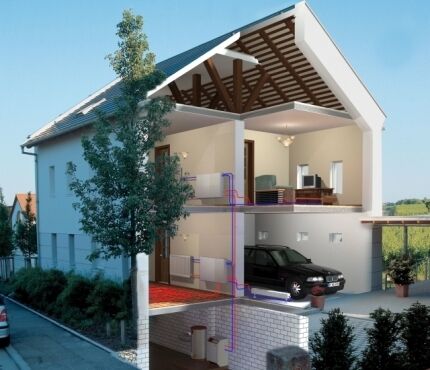
Depending on the type of water circulation in the pipes, heating systems come in two types:
- Natural – imply gravity flow of the coolant due to the laws of physics.
- Forced – assume the presence of a circulation pump to create a circulation of the thermal energy carrier from the boiler to the devices, and after cooling in the opposite direction.
The first option is simpler than the second in design and installation. But the heat supply in a natural system cannot be automatically controlled; the coolant in it moves through the pipes due to gravity and the difference in densities of cold and heated water. But unlike the forced option, it is non-volatile.
If the power supply is turned off, the heating system with natural circulation of water will continue to function properly if its main unit is a non-volatile boiler. There is also no pump that requires power from an outlet.
However, gravitational pressure has its limits. The heating power with natural circulation is simply not enough to supply coolant to branched circuits.
Sometimes it is not enough to supply heated water with the temperature required for heating at a distance between the radiator and the boiler of 25 m, if the pipeline is made of a material with high hydraulic resistance: steel or cast iron.
If a wooden house has a small area, then a natural system is quite enough for it. However, a large cottage of two or three floors requires a more powerful option with a pump that will pump hot water to all rooms remote from the boiler on all floors.
In addition to using gas, the coolant can be heated by electricity or by burning other types of fuel. Also autonomous heating in a private housewhere there is no connection to the gas main, it is often organized using convectors, infrared heaters and heat pumps.
The choice of a specific heating system design method depends on many factors. The climate of the region of residence, the quality of home insulation, as well as the availability of one or another type of fuel are important here.
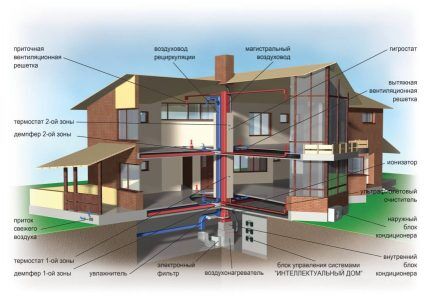
Heating circuits with steam and heated air circulating through them are arranged according to identical principles.
Particularly worth mentioning is the “warm floor” system, which is a network of pipes with a circulating coolant under the floor covering. The main advantage of this option is that as a result of heat coming from below, the air in the room is optimally heated at the level of human height, and not somewhere under the ceiling.
Alternative to gas: choosing a water heating boiler
Natural gas is far from the only type of fuel for autonomous heating systems. Boilers also burn solid or liquid fuel as fuel.
It is also possible to use electricity to heat water. Some people prefer traditional wood or coal stoves, while others prefer pure electricity. But it’s worth remembering that if there are power outages, electric boilers will be of no use.
Option #1: Solid fuel
Solid fuel stoves and their more modern analogues, boilers, are an ancient and most popular method of heating private houses in areas without gas. It could be like traditional Russian stoves, and modern boiler equipment industrial production with various automation.
The following are used as solid fuel:
- firewood;
- straw briquettes;
- peat;
- coal;
- wood pellets.
Such equipment is cheap and easy to use. Fuel is also not particularly expensive. However, as a result of its combustion, quite large volumes of ash are formed, which must be constantly disposed of. Plus, you have to visually monitor the operation of such equipment, which takes a lot of time.
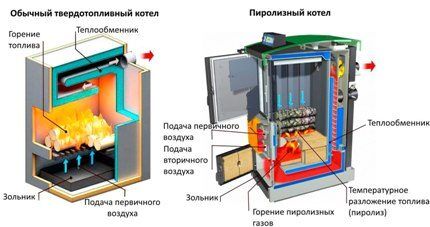
On the one hand, the cheapness of fuel, and on the other, regular cleaning of the firebox and chimney pipes. There is no clear decision “for” or “against” here. But in the situation of living near coal deposits or near a forest, the choice in favor of solid fuel boilers or stoves is obvious for many, and often the only possible one.
You can safely consider a fireplace as an option for a solid fuel unit, although there is a strong opinion about its low efficiency.However, when installed correctly, a fireplace is not only a decorative element of the interior, but also a good alternative to gas boilers. Moreover, it is completely energy-independent, which eliminates interruptions in heating in the event of any problems on the power grid.
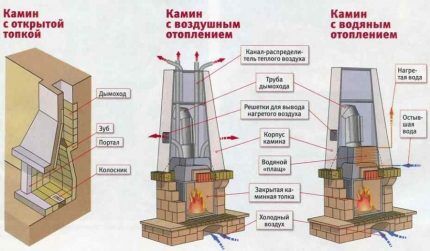
Most fireplaces are designed in such a way that they can only heat one room. However, the standard fireplace design can be supplemented with a coil around the chimney, which will heat water for the radiators of the heating system. Or you can immediately distribute warm air throughout the rooms using air ducts with adjustable dampers.
Fireplace heating is highly inert. It takes a lot of time for them to warm up a private house. The best option is to light the fireplace constantly. However, in this case you will need a lot of firewood. But all these minor inconveniences are more than offset by the opportunity to observe the process of burning logs and the aesthetics of your own home.

Option #2: Liquid fuel
In terms of efficiency, liquid fuel (diesel) boilers differ little from their gas counterparts. However, they are larger and heavier. Their installation requires a separate non-residential premises. Installing them in a cottage under the stairs or in the kitchen is strictly prohibited.
The combustion of vegetable oils and petroleum products produces significant amounts of harmful emissions.The boiler room for these installations must be equipped with high-quality ventilation and a smoke exhaust system. Plus, if installed and used incorrectly, they can start to smoke.
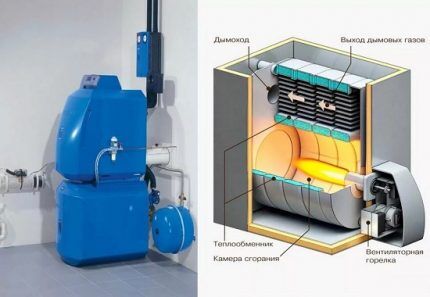
The following types of liquid fuel are used to heat private wooden houses:
- Kerosene.
- Diesel fuel.
- Development of fuel and lubricants.
- Fuel oil.
- Biofuel from vegetable oils.
Due to the specific smell and high probability of ignition, it is recommended to store such fuel outside the cottage. But in winter, liquids freeze outside, so you will have to make a separate heated room for such fuel or organize its preheating. And these are additional and significant expenses.
Among the advantages of using liquid fuel equipment For heating, it is worth noting the high efficiency, the absence of the need to obtain permits for installation and the autonomy of operation.
However, the high price of fuel outweighs all these advantages. It is worth organizing heating of a wooden house without gas using a diesel boiler only in cases where there is no other alternative, and it is not even foreseen in the future.
Option #3: Electricity
Electric boilers do not require a chimney. They are safe and compact in size. Heating of the coolant inside them occurs due to the heating element. Electric boilers can be used as both the main and additional sources of thermal energy. They are easy to use and efficient, but heating with their help is quite expensive.
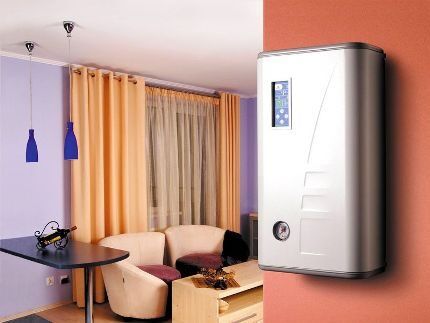
If the power grid in the village does not provide constant voltage, then choose electric boiler for heating owning a wooden house is risky. At some point, you may be left without lighting and a heating system at the same time. The only option in such a case is a backup diesel generator.
The power allocated by power engineers is not always enough to fully heat a cottage. And installing an additional power supply line will result in serious waste of money.
Installation and heating electrical equipment are relatively cheap, but the latter consumes a lot of electricity. If you plan to install heating in a private house without gas using an electric boiler, then you should prepare in advance for a serious increase in electricity bills.
About how much electricity an electric boiler will consume during heating, written here. We recommend that you read the information provided.
How else can you heat a wooden house?
To create comfortable conditions in the rooms of the cottage, you can use other heating methods. There are now a lot of new products on the autonomous heating equipment market. Some of them have a high price, but are highly effective. And others involve the use of alternative energy sources.
Infrared Heating Options
The main feature of IR heat sources is that they heat not the air, but objects and surfaces in the heated room. Already from heated furniture, walls and floors, heat is transferred to air masses into the room. As a result, with minimal energy consumption, it is possible to create the most comfortable conditions in your home.
Electric heaters with infrared radiation are sold as:
- suspended panels in housings of various shapes;
- film devices for installation on the ceiling or floor;
- floor-standing models (a la a regular radiator).
Functioning IR heaters in automatic mode. Just plug them into a power outlet and set them to the desired temperature.
Installation of wall and ceiling models is extremely simple; all necessary fastenings are provided in the housing or on the film. Only the installation of a “warm infrared floor” can cause difficulties. But if you strictly follow the instructions, everything is done in an elementary way.
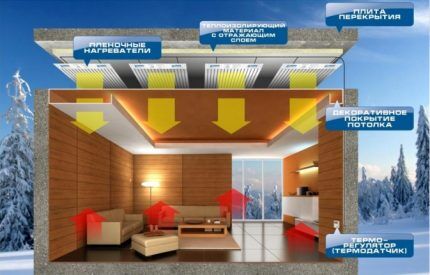
IR heaters allow you to quickly create a reliable and efficient heating system in any private home where there is no gas. When compared with an electric heating boiler, they provide savings of 30–40%. Moreover, the heating of the rooms occurs an order of magnitude faster, almost instantly.
Infrared heating devices can be used as the main source of heat or complement other heating systems for the cottage. The diversity of the model range makes it possible to fit them into any interior, and, if necessary, quickly increase the thermal power.
Among the negative aspects of IR electric heaters are static electricity, which attracts dust, and considerable initial capital investment. Nothing much can be done about statics, and the cost of equipment is always recouped due to low energy consumption.
Heat pumps as a useful addition
Among the alternatives to gas for heating a wooden house, heat pumps stand out, extracting it from the environment. Structurally and technically, this is an air conditioner in reverse.
Only the heat pump does not cool the air, but heats it. Moreover, it generates all the thermal energy necessary for this through the wise use of free natural resources and phenomena.

Flaw heat pumps lies in their dependence on the presence of voltage in the outlet. They will not work without a constant power supply. Plus, in severe frosts their effectiveness decreases sharply. In warm regions with winter temperatures around zero, their performance is excellent, but in Siberian conditions they are of little use.
Low potential heat heat pumps can collect from:
- street air;
- land through wells or pipe systems in the ground;
- water (any nearby reservoir or wells).
Heat pumps are good for everyone. However, you have to pay a lot for “free” energy by purchasing expensive equipment. For a large house, costs can exceed a million rubles.
Solar energy and wind turbines
Another option for “green” energy is solar panels And collectors. The former generate electricity, and the latter, using the rays of the sun, heat the coolant for supply to the intra-house heating system. They do not require any gas to operate; they only need a constant wind and cloudless weather.
In the future, electricity and heated coolant can be used to heat a private home by installing a heating system with radiators and various electric heaters.
Solar power plants are generators of electrical and thermal energy. The heating of the rooms itself is carried out thanks to a variety of heating devices that are connected to these generating devices.
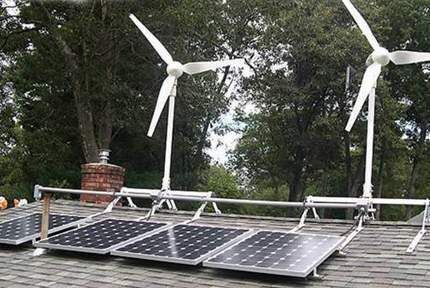
In turn, wind generators convert wind energy into electricity. And then the heaters are connected to the power supply.
The main disadvantage of all these clean energy sources is that they depend on external factors. Cloudy weather and calm negates their effectiveness. As an additional source, they are a completely suitable option for heating a private house without gas, but it is not worth building the entire heating system on them alone.
The most economical heating option
From the point of view of fuel costs, the most economically profitable option after mains gas is the option with firewood. It is difficult to find cheaper fuel for boilers, stoves and fireplaces.
Then comes coal, and then electricity and diesel. In the case of alternative energy, the costs for this item are generally zero or minimal. However, we should not forget here about the cost of thermal engineering units for generating heat.
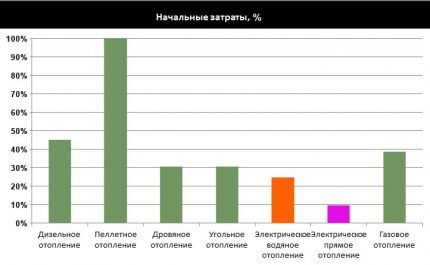
Based on the totality of all costs, it is cheaper to heat a house without gas using electricity. But this only applies to cottages with good insulation, as well as situations where the power of existing networks allows connecting electrical heating equipment. In other situations, it is better to opt for more traditional solid fuel stoves or boilers.
The arguments for choosing the most economical option for heating a private home are outlined in the next article, the contents of which we advise you to familiarize yourself with.
Conclusions and useful video on the topic
Heating a wooden cottage with a combination boiler (solid fuel + electricity):
What is the cheapest way to heat a house outside the city:
What is the most convenient way to heat a country house:
To heat private houses without gas, you can use either a classic wood stove or units that convert liquid fuel or electricity into thermal energy.
There is no universal advice on choosing equipment and type of fuel. It is necessary to carefully evaluate the characteristics of the cottage and the availability of resources for heating the coolant. However, without consulting a competent engineer, you can make a big mistake in this matter.
Write what type of heating you chose to decorate your country house. Please leave comments, ask questions, and post photos on the topic in the block below. We are interested in your opinion regarding the information presented in the article.




The information is useful, but personally I don’t understand why so much trouble is needed. I tried heating with wood and I really regret it: the wall has rotted to hell, I constantly need to add more wood. If you didn’t give it a boost, that’s it, the house cools down in a matter of minutes. Electric heating is a good option, but it depends on the width of your wallet. I don’t know about liquid fuel, you can try it.
Hello. A few minutes is brutal, of course. In general, I’m surprised how cooling happens so quickly... when you light a fireplace with an open firebox with wood (!!!), and this, mind you, is never a heating method at all. Our house stayed warm for at least half an hour with the chimney open until the coals burned out. It feels like you should think about insulating your home.
Electrics are very expensive. Take even the minimum - a 2 kW boiler. A day is 48 kW, a month is 1440 kW. With a tariff of 4 rubles - almost 6 thousand for heating alone.Unless you also take into account that in severe frosts you will have to turn on 4 kW. But in some regions there are discounts for those who rely entirely on electricity, and there is also a 30% subsidy for any utility service for large families.
We considered the option of “green” energy – solar panels and wind energy – as an opportunity for real savings. Fortunately, our location allows us. Frequent gusts of wind and rare precipitation can be considered as a means of saving. I would also like information on how to install a solar battery yourself and use it in the heating circuit of a private household.
Regarding the issue of heating a house from solar systems, the website has separate article on this issue. If you are considering the option of generating electrical energy and using it to power the boiler, then you will need to install solar panels, an inverter and batteries. By the way, it is not necessary to install solar panels on the roof of the house; you can build special frames for them on the site near the house.
You also write that you can use not only the energy of the sun, but also the wind, in which case I recommend that you read this article. If you have any specific questions during the implementation of such a project, ask them here, I will try to answer as quickly as possible.
If it's not a secret, then write what latitudes you are in?
It is easier and cheaper to use Ressi convectors.